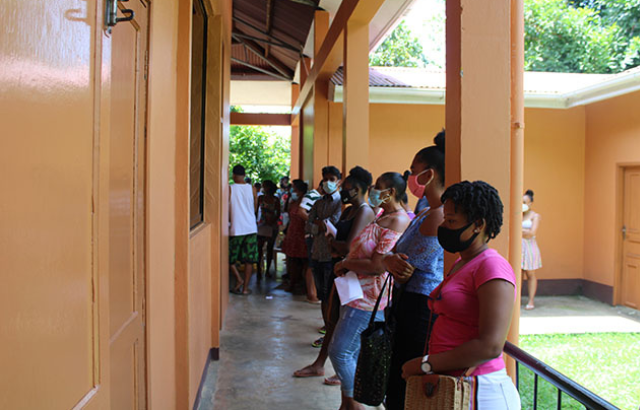Vaccine hesitancy – or not? Acceptance of COVID-19 vaccines is surprisingly high in LMICs; why does this matter for other vaccines?
Authors: Giuliano Russo, Stella Ladi, and Dominik Zenner

Vaccination centre in the Seychelles
There can be many, complex reasons for refusing COVID-19 vaccines, particularly if you live in low- and middle-income countries (LMICs). Perception about risks and benefits can be shaped by how much (or little) the virus has affected your community, trust in the vaccine development and production process, or even by the short shelf-life of donated vaccines. But, contrary to expectations, new evidence shows that there is a surprising willingness among populations in LMICs to get vaccinated for COVID-19; this offers an unexpected opportunity to revitalise stagnating global vaccination programmes for other diseases. Governments and international organisations should take advantage of the policy lessons learned during this pandemic to nudge demand for life-saving vaccines.
Early in the pandemic, many thought that LMICs were going to be hit the hardest by the new coronavirus because of their pre-existing health conditions and fragile health systems. High vaccine prices, global markets, supply chain failures, and the complexity of administering sensitive pharmaceutical products in remote rural areas, raised well-founded concern that poorer countries might lag in the race to vaccinate the world. There was also concern that vaccine hesitancy – a delay in acceptance or a refusal of vaccines despite the availability of vaccination services not uncommon in richer parts of the world –, was going to find fertile ground in lower-income settings. But two years on, the evidence tells a different story.
A recent high-level review of COVID-19 vaccine acceptance rates in high- and low-income countries has found an unexpected willingness to take COVID-19 vaccines in the latter. An interest in personal protection, rather than of the wider community, appeared to be a key driver, as well as fewer concerns around vaccine effectiveness and side effects. The hope is that future vaccination campaigns in those countries will be able to translate high levels of acceptance into actual uptake”
But low levels of hesitancy do not amount to vaccine uptake. Availability, accessibility, and affordability of vaccines remain key factors to translate willingness to vaccinate into uptake and comprehensive coverage. Such high levels of acceptance of COVID-19 vaccines are welcome, also because lessons can be learned for the other vaccines and immunization efforts for other diseases.
WHO and UNICEF data show that even before the pandemic, the drive to improve uptake and coverage of other vaccines - such as those for measles, polio, tuberculosis, or diphtheria, tetanus and pertussis (DPT3) - was losing momentum in low- and middle-income countries. While global trends in the 1980s showed a rapid expansion in immunization coverage, a slower pace of progress set in after the 2000s, followed by a gradual plateauing through 2019. The causes for such long stagnation in vaccination coverage levels are multi-layered, and deeply seated in health inequalities within and across countries, weak health systems, and humanitarian or political crises. A new challenge has come from parental reluctance to vaccinate their children because of lack of trust in healthcare systems and misinformation about vaccine safety.
The pandemic has exacerbated this stagnation of immunization coverage, with hospital closures, health workers’ reduced availability, and suspension of vaccinations campaigns, putting at risk the gains of the last two decades. A recent Lancet study showed a one third decline in the administration of DPT3 doses in the first year of the pandemic in South East Asia and Africa. Vaccinations rates picked up again towards the end of 2020, leaving nonetheless behind a cohort of unvaccinated children.
A few lessons can be learned from the COVID-19 vaccine experience to help revitalise global vaccination efforts. First, although availability and accessibility of vaccines is paramount, demand-side factors appear to matter for expanding coverage globally, particularly in culturally diverse contexts. To this respect, a Cochrane Review identified the most effective demand-side interventions to improve immunization coverage, from health education at villages and home levels, to facility-level education and vaccination reminder cards, or monetary incentives paired with home visits.
But most importantly, the COVID-19 experience has highlighted the need to go under the skin of the context-specific, culturally driven causes of low uptake for specific vaccines in different parts of the world. Low vaccination rates have numerous reasons and cannot be the same in diverse settings. By the same token, policies to increase uptake will need to be tailor-made and respond to context-specific political and administrative challenges. Co-creation of vaccine policies, and engagement with the community, will be key to increasing uptake and fighting misinformation.
Related items
For media information, contact: